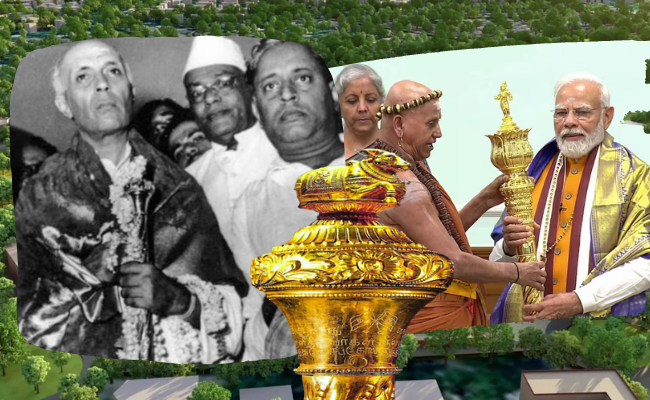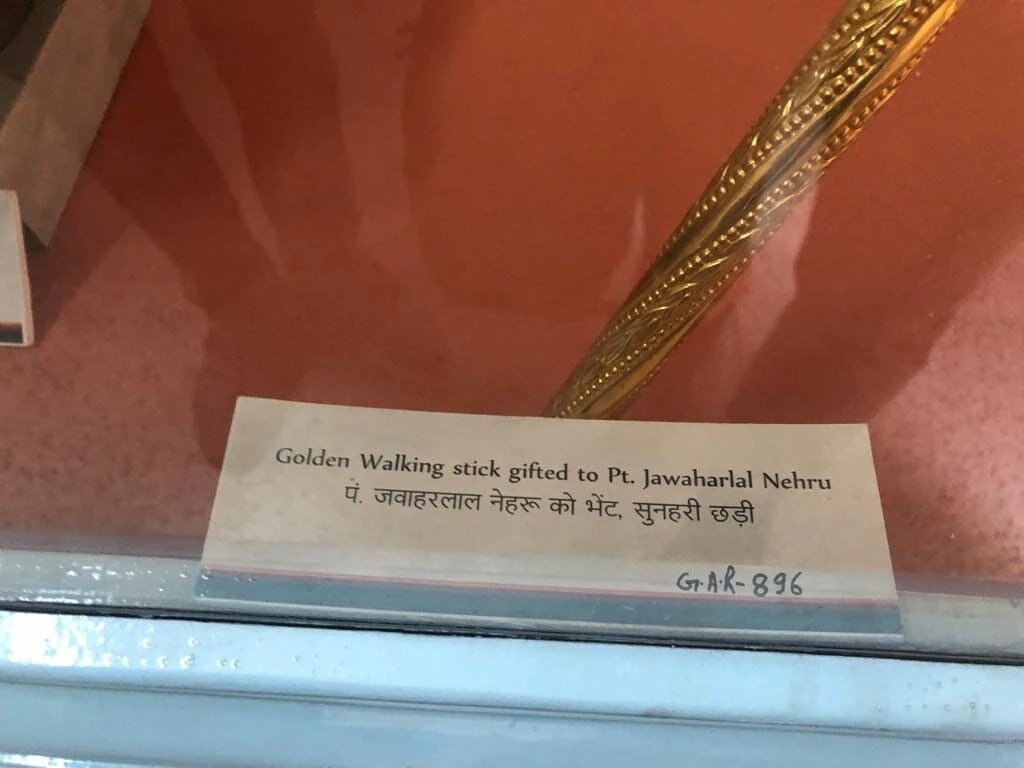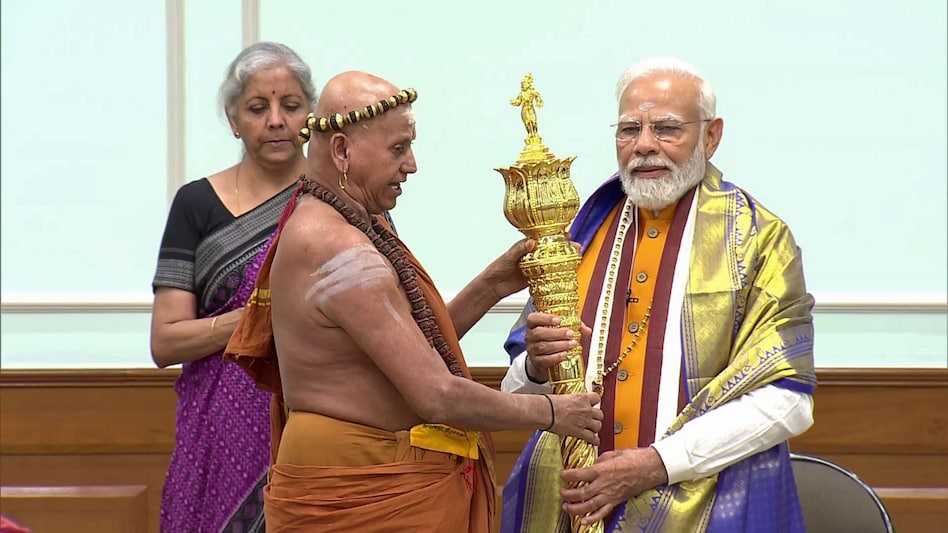.gif)
.gif)

On the auspicious eve of August 14, 1947, India stood on the precipice of freedom, poised to liberate itself from the clutches of British dominion. The remarkable Jawaharlal Nehru, the first Prime Minister of independent India, stood at the threshold of a new era, ready to receive a profound symbol of authority—the illustrious Sengol. This emblematic artifact, measuring an impressive five feet in length, signified the meaningful transfer of power from the British rulers to the Indian people.
Crafted with meticulous artistry, the Sengol epitomized the splendor of Indian craftsmanship, reflecting its rich heritage from top to bottom. Adorned with intricate details, the majestic orb of the scepter represented the globe itself, representing the vastness and interconnectedness of the world. Resting upon this resplendent sphere, a magnificent carving of Nandi, the sacred bull of Lord Shiva, stood as a testament to justice and righteousness.
The origins of this golden scepter can be traced back to the golden era of the Chola empire. In the realm of the Chola kingdom, the transfer of power from one sovereign to another was marked by the ceremonial bequeathal of the Sengol—a magnificent staff resplendent in gold, adorned with the divine visage of Nandi, the eternal symbol of justice.
As the momentous occasion of transferring power from the British rulers to the Indian people unfolded, a pressing question lingered in the minds of the deliberators—how should this historic transition be symbolized? In search of an answer, Jawaharlal Nehru turned to C. Rajagopalachari, a distinguished freedom fighter hailing from Tamil Nadu. It was Rajaji, drawing inspiration from the annals of India's glorious past, who discovered the profound significance of the Chola traditions. Thus, the timeless symbol of the Sengol emerged as the perfect embodiment of this transformative moment, bridging the legacy of the Chola empire with the dawn of India's newfound freedom.
In the year 1947, during a pivotal quest for a symbol that would embody the monumental transfer of power, C. Rajagopalachari reached out to the esteemed Dharmic Math of Thiruvavaduthurai Adheenam. With great reverence, the revered seer of that time graciously accepted the significant task and entrusted the esteemed jeweler, Vummidi Bangaru of Madras, with the sacred responsibility of creating the illustrious Sengol.
A team of ten skilled gold craftsmen, their hands guided by devotion and expertise, dedicated themselves to the meticulous creation of the Sengol. Throughout ten to fifteen days, this extraordinary piece of artistry came to life, emanating brilliance and opulence under their expert hands.
The revered seer, accompanied by his trusted deputy, Sri La Sri Kumaraswamy Thambiran, embarked on a momentous journey to the city of Delhi, carrying with them the precious Sengol and the weight of history. In a solemn ceremony, Sri La Sri Thambiran presented the resplendent scepter to Lord Mountbatten, the viceroy entrusted with overseeing the transfer of power. In a symbolic gesture, Lord Mountbatten graciously returned the Sengol, signifying the end of an era under foreign rule.

To ensure its sanctity, the Sengol underwent a sacred purification ritual, wherein holy water was reverently sprinkled upon its divine form. It was then entrusted to the custody of Nehru's abode, where destiny awaited its arrival.
However, the significance of this historic Sengol, once placed in the hands of Jawaharlal Nehru himself, gradually faded into obscurity. Regrettably, its importance was diminished over time, and it found itself relegated to the confines of the Allahabad Museum, shielded by a misleading label. Tragically misidentified as the "Golden walking stick gifted to Pandit Jawaharlal Nehru," this magnificent golden scepter stood as a forgotten testament to the grandeur of India's past and the profound moment of its liberation.

During the grand festivities of the Azadi ka Amrit Mahotsav last year, the resplendent Sengol and its profound significance emerged from the depths of history, captivating the nation once again. A spark was ignited by media reports, breathing new life into the tale of this remarkable symbol, resonating with the essence of freedom and unity.
Renowned dancer Padma Subrahmanyam, driven by her unwavering commitment to preserving cultural heritage, embarked on a remarkable mission. With utmost dedication, she meticulously translated an enlightening article on the Sengol from Tamil to English, recognizing the importance of sharing its narrative with a wider audience. Fueled by a profound desire, she humbly forwarded her translation to the esteemed corridors of power—the Prime Minister's Office (PMO)—in a heartfelt plea to locate the whereabouts of this historic golden scepter.
In a momentous revelation, Finance Minister Nirmala Sitharaman unveiled the impact of this fervent endeavor. Her announcement revealed that on May 28, a momentous occasion would unfold. It would be on this auspicious day that Prime Minister Narendra Modi himself would grace the event, adorning the pages of history. With great reverence, he would install the resplendent scepter within a magnificent glass case, an epitome of honor and veneration. This cherished artifact would find its rightful place adjacent to the dignified Speaker's seat in the splendid halls of the new Parliament building.

This grand gesture stands as a testament not only to the rediscovery of a cherished relic from the tapestry of time but also as a symbol of India's glorious heritage. As the Sengol assumes its rightful place, encased in the ethereal embrace of glass, it embodies the enduring spirit of freedom, justice, and unity, reverberating within the hearts of a nation. Through this poignant act, the nation pays homage to its past, revels in the present, and paves the way for an inspired future—a future illuminated by the indomitable spirit of India's hard-fought independence.